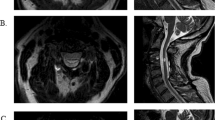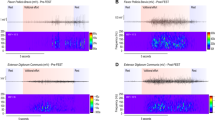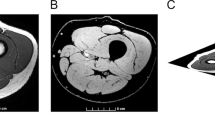Abstract
Complete spinal cord injury (SCI) results in inactivation and unloading of affected skeletal muscles. Unloading causes an increased susceptibility of muscle to contraction-induced injury. This study used magnetic resonance imaging (MRI) to test the hypothesis that isometric contractions would evoke greater muscle damage to the quadriceps femoris muscle (mQF) of SCI subjects than that of able-bodied (AB) controls. MR images were taken of the mQF prior to, immediately post, and 3 days post electromyostimulation (EMS). EMS consisted of five sets of ten isometric contractions (2 s on/6 s off, 1 min between sets) followed by another three sets of ten isometric contractions (1 s on/1 s off, 30 s between sets). Average muscle cross-sectional area (CSA) and the relative areas of stimulated and injured muscle were obtained from MR images by quantifying the number of pixels with an elevated T2 signal. SCI subjects had significantly greater relative area [90 (2)% versus 66 (4)%, P<0.05; mean (SE)] but a lesser absolute area [16 (3) cm2 versus 44 (6) cm2, P<0.05] of mQF stimulated than AB controls. During EMS, peak torque was reduced by 66% and 37% for SCI and control subjects, respectively. Three days post EMS, there was a greater relative area of stimulated mQF injured for the SCI subjects [25 (6)% versus 2 (1)%, P<0.05]. Peak torque remained decreased by 22% on day 3 in the SCI group only. These results indicate that affected muscle years after SCI is more susceptible to contraction-induced muscle damage, as determined by MRI, compared to AB controls. They also support the contention that electrically elicited isometric contractions are sufficient to cause muscle damage after a prolonged period of inactivity.




Similar content being viewed by others
References
Adams GR, Duvoisin MR, Dudley GA (1992) Magnetic resonance imaging and electromyography as indexes of muscle function. J Appl Physiol 73:1578–1583
Adams GR, Harris RT, Woodard D, Dudley GA (1993) Mapping of electrical muscle stimulation using MRI. J Appl Physiol 74:532–537
Akima H, Ito M, Yoshikawa H, Fukunaga T (2000) Recruitment plasticity of neuromuscular compartments in exercised tibialis anterior using echo-planar magnetic resonance imaging in humans. Neurosci Lett 296:133–136
Appell HJ (1986) Morphology of immobilized skeletal muscle and the effects of a pre- and postimmobilization training program. Int J Sports Med 7:6–12
Baldwin AC, Stevenson SW, Dudley GA (2001) Nonsteroidal anti-inflammatory therapy after eccentric exercise in healthy older individuals. J Gerontol A Biol Sci Med Sci 56:M510–513
Castro MJ, Apple DF Jr, Hillegass EA, Dudley GA (1999a) Influence of complete spinal cord injury on skeletal muscle cross-sectional area within the first 6 months of injury. Eur J Appl Physiol Occup Physiol 80:373–378
Castro MJ, Apple DF Jr, Staron RS, Campos GE, Dudley GA (1999b) Influence of complete spinal cord injury on skeletal muscle within 6 months of injury. J Appl Physiol 86:350–358
Castro MJ, Apple DF Jr, Rogers S, Dudley GA (2000) Influence of complete spinal cord injury on skeletal muscle mechanics within the first 6 months of injury. Eur J Appl Physiol 81:128–131
Clarkson PM, Newham DJ (1995) Associations between muscle soreness, damage, and fatigue. Adv Exp Med Biol 384:457–469
Clarkson PM, Nosaka K, Braun B (1992) Muscle function after exercise-induced muscle damage and rapid adaptation. Med Sci Sports Exerc 24:512–520
Conley MS, Meyer RA, Bloomberg JJ, Feeback DL, Dudley GA (1995) Noninvasive analysis of human neck muscle function. Spine 20:2505–2512
Dudley GA, Czerkawski J, Meinrod A, Gillis G, Baldwin A, Scarpone M (1997) Efficacy of naproxen sodium for exercise-induced dysfunction muscle injury and soreness. Clin J Sport Med 7:3–10
Dudley GA, Castro MJ, Rogers S, Apple DF Jr (1999) A simple means of increasing muscle size after spinal cord injury: a pilot study. Eur J Appl Physiol Occup Physiol 80:394–396
Fisher MJ, Meyer RA, Adams GR, Foley JM, Potchen EJ (1990) Direct relationship between proton T2 and exercise intensity in skeletal muscle MR images. Invest Radiol 25:480–485
Foley JM, Jayaraman RC, Prior BM, Pivarnik JM, Meyer RA (1999) MR measurements of muscle damage and adaptation after eccentric exercise. J Appl Physiol 87:2311–2318
Gibala MJ, MacDougall JD, Tarnopolsky MA, Stauber WT, Elorriaga A (1995) Changes in human skeletal muscle ultrastructure and force production after acute resistance exercise. J Appl Physiol 78:702–708
Grimby G, Broberg C, Krotkiewska I, Krotkiewski M (1976) Muscle fiber composition in patients with traumatic cord lesion. Scand J Rehabil Med 8:37–42
Hather BM, Adams GR, Tesch PA, Dudley GA (1992) Skeletal muscle responses to lower limb suspension in humans. J Appl Physiol 72:1493–1498
Hillegass EA, Dudley GA (1999) Surface electrical stimulation of skeletal muscle after spinal cord injury. Spinal Cord 37:251–257
Hopman MT, Dueck C, Monroe M, Philips WT, Skinner JS (1998) Limits to maximal performance in individuals with spinal cord injury. Int J Sports Med 19:98–103
Krippendorf BB, Riley DA (1993) Distinguishing unloading- versus reloading-induced changes in rat soleus muscle. Muscle Nerve 16:99–108
Krippendorf BB, Riley DA (1994) Temporal changes in sarcomere lesions of rat adductor longus muscles during hindlimb reloading. Anat Rec 238:304–310
LeBlanc A, Evans H, Schonfeld E, Ford J, Schneider V, Jhingran S, Johnson P (1987) Changes in nuclear magnetic resonance (T2) relaxation of limb tissue with bed rest. Magn Reson Med 4:487–492
Mair J, Koller A, Artner-Dworzak E, Haid C, Wicke K, Judmaier W, Puschendorf B (1992) Effects of exercise on plasma myosin heavy chain fragments and MRI of skeletal muscle. J Appl Physiol 72:656–663
Martin TP, Stein RB, Hoeppner PH, Reid DC (1992) Influence of electrical stimulation on the morphological and metabolic properties of paralyzed muscle. J Appl Physiol 72:1401–1406
Narici MV, Roi GS, Landoni L, Minetti AE, Cerretelli P (1989) Changes in force, cross-sectional area and neural activation during strength training and detraining of the human quadriceps. Eur J Appl Physiol Occup Physiol 59:310–319
Ploutz-Snyder LL, Tesch PA, Hather BM, Dudley GA (1996) Vulnerability to dysfunction and muscle injury after unloading. Arch Phys Med Rehabil 77:773–777
Ploutz-Snyder LL, Nyren S, Cooper TG, Potchen EJ, Meyer RA (1997) Different effects of exercise and edema on T2 relaxation in skeletal muscle. Magn Reson Med 37:676–682
Ploutz-Snyder LL, Tesch PA, Dudley GA (1998) Increased vulnerability to eccentric exercise-induced dysfunction and muscle injury after concentric training. Arch Phys Med Rehabil 79:58–61
Prior BM, Jayaraman RC, Reid RW, Cooper TG, Foley JM, Dudley GA, Meyer RA (2001) Biarticular and monoarticular muscle activation and injury in human quadriceps muscle. Eur J Appl Physiol 85:185–190
Riley DA, Thompson JL, Krippendorf BB, Slocum GR (1995) Review of spaceflight and hindlimb suspension unloading induced sarcomere damage and repair. Basic Appl Myol 5:139–145
Robergs RA, Appenzeller O, Qualls C, Aisenbrey J, Krauss J, Kopriva L, DePaepe J (1993) Increased endothelin and creatine kinase after electrical stimulation of paraplegic muscle. J Appl Physiol 75:2400–2405
Rochester L, Chandler CS, Johnson MA, Sutton RA, Miller S (1995) Influence of electrical stimulation of the tibialis anterior muscle in paraplegic subjects. 1. Contractile properties. Paraplegia 33:437–449
Round JM, Barr FM, Moffat B, Jones DA (1993) Fibre areas and histochemical fibre types in the quadriceps muscle of paraplegic subjects. J Neurol Sci 116:207–211
Scelsi R, Marchetti C, Poggi P, Lotta S, Lommi G (1982) Muscle fiber type morphology and distribution in paraplegic patients with traumatic cord lesion. Histochemical and ultrastructural aspects of rectus femoris muscle. Acta Neuropathol (Berl) 57:243–248
Shellock FG, Fukunaga T, Mink JH, Edgerton VR (1991a) Acute effects of exercise on MR imaging of skeletal muscle: concentric versus eccentric actions. AJR Am J Roentgenol 156:765–768
Shellock FG, Fukunaga T, Mink JH, Edgerton VR (1991b) Exertional muscle injury: evaluation of concentric versus eccentric actions with serial MR imaging. Radiology 179:659–664
Stevenson SW, Dudley GA (2001) Dietary creatine supplementation and muscular adaptation to resistive overload. Med Sci Sports Exerc 33:1304–1310
Takahashi H, Kuno S, Miyamoto T, Yoshioka H, Inaki M, Akima H, Katsuta S, Anno I, Itai Y (1994) Changes in magnetic resonance images in human skeletal muscle after eccentric exercise. Eur J Appl Physiol Occup Physiol 69:408–413
Triffletti P, Litchfield PE, Clarkson PM, Byrnes WC (1988) Creatine kinase and muscle soreness after repeated isometric exercise. Med Sci Sports Exerc 20:242–248
Warren GL, Hayes DA, Lowe DA, Williams JH, Armstrong RB (1994) Eccentric contraction-induced injury in normal and hindlimb-suspended mouse soleus and EDL muscles. J Appl Physiol 77:1421–1430
Acknowledgements
The authors would like to thank the subjects for their participation in this study. We also appreciate Chris Elder (UGA) and Carolyn Sharp (SC) for their technical expertise and Gordon Warren, Ph.D. for critical review of the initial draft of this manuscript. Funding was provided, in part, by the Shepherd Center (J.M.S., C.S.B., and G.A.D.), the Foundation for Physical Therapy (CSB) and the National Institutes of Health (HD37439-S1 and HD 39676 to G.A.D.).
Author information
Authors and Affiliations
Corresponding author
Rights and permissions
About this article
Cite this article
Bickel, C.S., Slade, J.M. & Dudley, G.A. Long-term spinal cord injury increases susceptibility to isometric contraction-induced muscle injury. Eur J Appl Physiol 91, 308–313 (2004). https://doi.org/10.1007/s00421-003-0973-5
Accepted:
Published:
Issue Date:
DOI: https://doi.org/10.1007/s00421-003-0973-5




